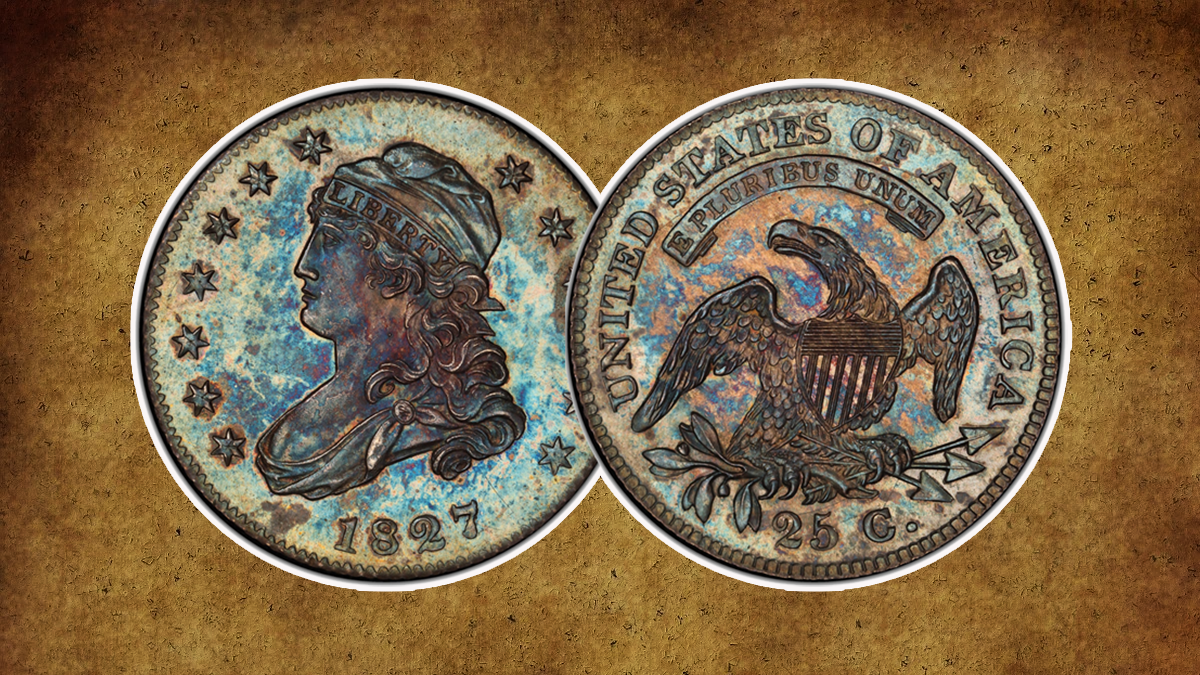
The Quarter Dollar is a United States coin and its worth is 25 cents. It has been made intermittently since 1796 and continually since 1831. The Capped Bust design was known as the Liberty Cap Quarter, and it was the second type of quarter dollar provided into circulation, replacing the Draped Bust quarter in 1815.
History and Significance
The Capped Bust quarter was introduced in 1815 and remained in circulation until 1838. It featured a new eagle reverse design, which listed the value as “25 cents” rather than “quarter dollar,” as seen on later coins. The obverse design, common for the half dime, dime, quarter, and half dollar of the time, depicted Liberty wearing a soft cap. This design was created by John Reich and later modified by Chief Engraver William Kneass. After 1838, the design was replaced by the Seated Liberty design. Though modern quarters are now made of copper-nickel, these older coins remain legal tender, though their numismatic value far exceeds their face value.
Features
- Obverse Design: Portrait of Liberty with a soft cap.
- Reverse Design: American Eagle with the denomination “25 cents.”
- Designers: John Reich and William Kneass.
- Material: 0.892 silver.
- Weight: 6.740 grams.
- Diameter: 27.000 mm.
- Technology: Milled (machine-made).
- Orientation: Coin Alignment (Axis 6).
Rarity
The 1827 Capped Bust quarter is one of the most desirable and rarest quarters in American numismatics. Only 4,000 of these coins were minted at the Philadelphia Mint, making it highly sought after by collectors. The 1827 quarter became even more famous due to the restrikes made by the Mint, indicating its popularity.
Specifications
- Country: United States
- Currency: US Dollar
- Face Value: 25 cents
- Circulation Mintage: 4,000
- Total Mintage: 4,000
- Mint: Philadelphia Mint
- Mint Mark: None
- Shape: Round
The 1827 Capped Bust quarter is not only a piece of currency but a significant artifact of American history, reflecting the early years of the United States Mint and its evolving coinage technology.
Design of 1827 Capped Bust quarter
Obverse
The coin’s obverse shows a picture of Liberty facing left, her hair wrapped by a fabric cap fastened with an elastic band with the word “LIBERTY,” and her tresses flowing down to her shoulder. A dress is draped around her neck and connected at the shoulder with a brooch.
Thirteen stars, six to the right and seven to the left, around the rim, representing the original thirteen states.
The date of release appears below the portrait: 1827.
There are beads on the rim.
Reverse
The main focus on the opposite side is a perched, open-winged eagle looking left. The Union Shield, with thirteen white and red vertical stripes and a blue horizontal bar on top, has its center on its breast. Heraldic hatching, utilizing thin lines to indicate color (horizontal stripes for blue, vertical for red, and no stripes for white), is used to represent each color. From the eagle’s point of view, it has a branch of olives in its right talon and a bundle of three arrows in its left.
The combination of the arrows and olive branch reflects the US’s “strong desire for peace, but will always be ready for war.” The eagle is holding an olive branch in its beak, signifying its inclination towards serenity.
A scroll with the words “Out of Many, One” (E PLURIBUS UNUM) was located on top.
The words “UNITED STATES OF AMERICA” are written around the outer edge of the image. The shortened value and denomination, 25 C. (twenty-five cents), are displayed under the eagle.
There are beads on the rim.
How we can determine a restrike or an original?
To determine whether a coin is a restrike or an original, here are a few ways:
- Check the date: If the coin is dated before the 19th century, it is highly unlikely to be a restrike as the technology for restriking coins did not exist at that time.
- Examine for signs of wear: Restrikes are generally made from fresh dies, which indicates they will have sharper details than an actual coin. If a coin seems to have been worn, it is more possible to be an actual.
- Inspect the edge of the coin: Restrikes are often produced with a reeded edge, which can be an indicator of modern production. Original coins, on the other hand, may have lettering or design elements on the edge.
- Check the weight and dimensions: Restrikes may have slightly different weights and dimensions compared to an original coin. You can compare the weight and dimensions of the coin in question to those of an authentic original coin to determine whether it is likely to be a restrike.
- Research the coin’s history: Researching the history of the coin, including its provenance and previous owners, can provide clues as to whether it is an original or a restrike.
Originals vs Restrikes:
The 1827 Quarter Dollar restrike is one of the classic American coinage rarities. Technically, it is not a restrike in the purest sense but a ruling of an 1827 obverse with an old reverse from 1819. The restrikes are easily recognized by the square base 2 in “25C” on the reverse, while the originals have a curl base 2.
Originals
- The original 1827 quarters feature a curled base 2 in the denomination “25C.”
- These coins were struck using the dies intended for that year without any later alterations.
- The originals are rare and highly sought after by collectors.
Restrikes
- The restrikes have a square base 2 in the denomination “25C,” distinguishing them from the originals.
- Die evidence indicates that 1827 quarters were restruck on at least two different occasions.
- Period One Restrikes
- These restrikes come from a relatively clean, unrusted state of the dies.
- At least two of these restrikes were struck over 1806 quarters.
- Karl Moulton believes these were made specifically to test the efficacy of the close collars that were soon to be used on all U.S. coins.
- Period Two Restrikes
- These restrikes are from heavily rusted dies, indicating a later period of production.
Value and Recognition
Genuine 1827 Capped Bust Quarters are immensely valuable, especially original Proof coins, which can fetch hundreds of thousands of dollars at auction. Due to their high value, it is crucial to have these coins authenticated by reputable grading services like PCGS or NGC. Authentication ensures that collectors are getting genuine coins and helps maintain the coin’s value.
Also Read – 1796 Draped Bust Quarter: A Collector Guide
Conclusion
The 1827 Capped Bust Quarter is a rare and historically significant coin. Its distinction between originals and restrikes, along with its unique features, adds to its intrigue. Despite the passage of time, the 1827 Capped Bust Quarter continues to captivate and appeal to coin collectors worldwide.
